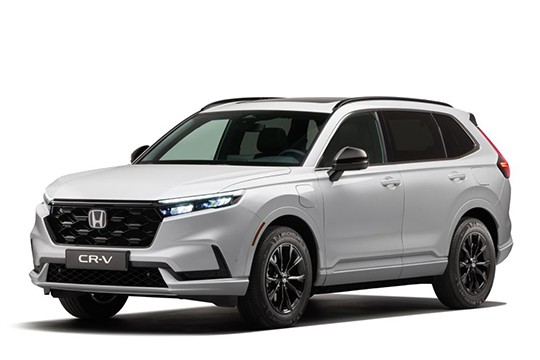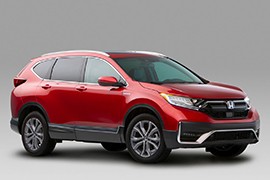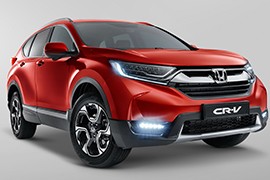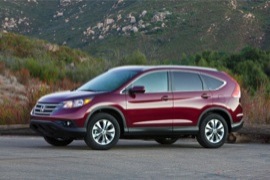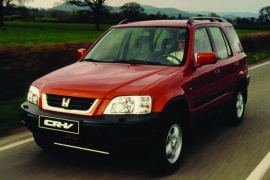HONDA CR-V Models/Series Timeline, Specifications & Photos
First production year: 1996
Engines: Hybrid gasoline, Plug-in hybrid, Gasoline, Hybrid, Diesel
Body style: SUV (Sports Utility Vehicle)
Honda unveiled the sixth generation of the European CR-V version in the spring of 2023 and it was different than its American sibling.
The Japanese automaker was one of the few to create specific versions of the same car on both sides of the Pond. Thus, even though at first sight it looked identical to the one sold on the North American continent, it was different in many aspects, especially on the exterior and on its mechanical underpinnings.
With the sixth generation of the CR-V, Honda completed the cycle of a unitary design language. The SUV's headlights were slim and angled upwards on their outer sides, resembling those installed on the Civic. The main grille sported a 3D hexagonal pattern that tried to conceal the diminished cooling area the car needed. On the lower side of the bumper, the European version featured a broad trapezoidal air intake flanked by air intakes meant to divert the airflow on the car's sides. While the profile showed a similar look, with an ascending line at the bottom of the third row of windows, the taillights were specific for the EU market, with red LEDs and red lenses. The American version, on the other hand, featured clear lenses.
Inside, the main difference could be noticed in the center console. The EU version boasted buttons for the gear selector, while the U.S. model received an actual shifter. Maybe it was more comfortable for Honda's customers or just a matter of taste. Still, both versions were fitted with a standard infotainment unit placed atop the center stack.
But the most crucial difference was for the drivetrains. The U.S. model was powered by a 1.5-liter turbocharged engine. On the other hand, the European version boasted a naturally aspirated 2.0-liter running in the Atkinson cycle. There were two versions available: a mild-hybrid and a plug-in hybrid.
Honda introduced the sixth generation of its best-selling model CR-V on the American market in the summer of 2022, improving the car's image and performance.
The CR-V started its journey in 1995 when SUVs were not highly popular among customers. Still, the Japanese carmaker gambled and scored big wins with that vehicle. Later on, Honda tried to achieve similar success with the larger Pilot but couldn't. By 2022, the CR-V was the best-selling SUV on the American market, its position being contested by more experienced SUV-makers. And yet, the compact SUV stood its ground with constant improvements and proverbial reliability.
With the 2022 model, the sixth generation of the CR-V showed a distinct front fascia that resembled other vehicles in Honda's lineup, such as the Accord, the Civic, and the HR-V. Its angled, narrow headlights were fitted with standard LEDs. The upright, broad grille featured a black mesh with chromed trim. From its profile, the beltline resembled a similar image to the one offered by the Ridgeline pickup. At the same time, out back, the designers reimagined the original concept of vertical taillights but extended them onto the tailgate.
Inside, the CR-V featured a spacious cabin, thanks to the increased wheelbase compared to its predecessor. Another important step forward was in the technology department, where the carmaker installed a 7" digital instrument panel complemented by a 7" or 9" touchscreen mounted atop the center stack. The redesigned front bucket seats offered better side support and comfort for long roads, while at the back, the 60/40 split-folding bench enlarged the trunk from a regular 36.3 cu-ft (1,027 liters) to an impressive 76.5 cu-ft (2,166 liters) when folded.
Under the hood, the CR-V boasted a new hybrid system that combined a 2.0-liter Atkinson-cycle inline-four with two electric motors mounted side-by-side. At the same time, the base version featured a turbocharged 1.5-liter unit that was mated to a CVT, which mimicked fixed gear ratios.
Honda introduced a major facelift for the CR-V's fifth generation in 2019, three years after the model's introduction at the 2016 Detroit Auto Show.
Being the best-selling crossover in the U.S. for more than two decades was not an easy job for the Japanese automaker. It had to face stiff competition from American, German, and other Asian car manufacturers. But still, somehow, Honda managed to be one step ahead of everyone else. So, to keep it that way, it refreshed the CR-V's fifth generation in 2019 for the 2020 model-year by improving the vehicle in all areas.
Honda's design team didn't look like it worked too much when they prepared the lines for the 2020 model-year. Still, at the front, the refreshed CR-V featured less chromed trims on the grille. At the same time, the lower bumper sported wider side scoops for the fog lights, creating a more aggressive look for the car. Depending on the trim level, some versions got LED bars for the fog lamps while others got round ones.
Inside, the CR-V sported a new 7" instrument panel for the driver and a same-size touchscreen placed atop the center stack for the infotainment system that was Android Auto and Apple CarPlay compatible. For the hybrid version, the CR-V sported buttons on the center console for drive modes and a set of paddles behind the steering wheel that controlled the energy recuperation programs.
Power came from either a turbocharged 1.5-liter inline-four engine or from a hybrid system. The latter consisted of a pair of motors and a 2.0-liter naturally-aspirated powerplant that worked in Atkinson-cycle.
After years of leading the SUV market in the U.S., Honda CR-V returned in 2016 with a new generation. The new, bold and sophisticated styling features a frontal fascia dominated by two headlights that looked like some samurai eyes. Its overall design was bold and sophisticated and started debates. It was a love-it or hate-it design.
Inside, there was plenty of room for everybody. The flat-floor in the rear made the access easier and offered better comfort even when three adults were seated. Inside, the dashboard was mounted into a lower position, with a very easy to read instrument cluster. The infotainment unit didn't match those which were already installed on the Civic from the same era since they couldn't be paired with Android Auto and Apple CarPlay.
Depending on the market, the 2018 CR-V had five engine options and few gearboxes available. It was the first CR-V to boast a gasoline turbocharged engine, on the 1.5-liter version. It also kept the older 2.4-liter and 2.0-liter but upgraded to the newest emission standards. The 1.6-liter turbodiesel engine was updated above the previous generation and a Hybrid version was added.
For the transmission, the CR-V was offered as a 2WD or 4WD. For the hybrid, it had a CVT only, but for the others had either a 6-speed manual or a 9-speed automatic.
The Japanese automaker unveiled the refreshed CR-V at the 2014 Paris Motor Show, showing a new image and an enhanced engine lineup.
With the new Euro 6 emission standards being applied on the Old Continent, Honda had to upgrade its engine lineup. While doing so, it also improved the car's look, which was not one of the best designs in its segment. But Honda's customers seemed like they were more concerned about technical bits and pieces than the car's look. For the U.S. customers, though, the Japanese brand focused on many areas, and the American-oriented CR-V looked different than its European-intended sibling.
Even though it kept the same angled headlights, its design was changed. In addition, there were new turn-signal areas that were stripped from their amber lenses. Moreover, Honda ditched the formerly used halogen-based bulbs for the daytime running lights and replaced them with LED ones. The grille sported a honeycomb pattern on the lower side, below the new blackened wide center slat. Finally, even though the CR-V was not really an off-road beast, the carmaker insisted on adding a metallic-gray trim on the lowest part of the bumper, mimicking an underbody shield.
Honda installed a graphic display inside the instrument cluster that took center stage in that multi-level panel. It now offered detailed info about the lane-keeping assist system, named LKAS, not only information regarding fuel consumption, range, or miles. The high-seating position was already appreciated by the CR-V's customers, and that was kept. Also, the gear selector kept its place on the center stack, not between the seats.
But the most significant changes happened under the car's skin. For starters, the U.S. version featured a 2.4-liter inline-four powerplant that sent its torque via a new CVT gearbox in all corners.
Honda introduced the U.S. version of the CR-V's fourth generation at the Los Angeles Auto Show in 2011, and the new model looked more stylish than its predecessor.
With an increased demand for SUVs and crossovers, Honda pushed hard to increase sales for the CR-V; the Japanese automaker still had to recover after the hits it took during the world financial crisis. The new model was not just a hope but a ticket to the carmaker's independence in a market where famous brands had ended up being purchased by some other small companies. Not Honda; it was not for sale.
The car's look was more refined with the flush, swept-back headlights. Between them, above the lower bumper, was a chromed three-slat grille. On the lower bumper, the automaker installed a pair of fog lamps and an underbody plastic shield. From its profile, the extended greenhouse and the third triangular window behind the rear doors created a dynamic image for the CR-V.
Inside, Honda didn't look like it paid too much attention to its customers. There was a pair of flat, individual seats at the front and a benchseat for three in the back. All occupants benefited from the car's roomy interior. In addition, the split-folding seatback allowed customers to load longer items through the raked-forward tailgate.
Depending on the market, the CR-V was available with either gasoline or turbo-diesel engines. It was a strategy that worked when the automaker's CEO visited all the Honda's locations in Europe. Customers were attracted by leather seats, the head-up display, and a panoramic glass roof. Still, the trunk area was not exactly big or impressive.
Honda offered the CR-V with a choice of gasoline and turbo-diesel engines. For those who didn't need an all-wheel drive vehicle, the automaker produced a front-wheel drive only version.
The CR-V was already a Honda’s best seller and 2010 came with a new design that was supposed to attract even more buyers.
The CR-V nameplate was on the market from 1997 when the first generation was released. “CR-V” stood for “comfortable runabout vehicle” . And exactly how the name describes it, the crossover was designed for families in need of comfort and lots of space.
The exterior design changes included a restyled front grille that worked nicely with the big headlamps, new front and rear bumpers and a restyled hood.
The CR-V came with 4 trim levels. The base version, the LX, was already equipped with some nice features such as cruise control, keyless entry, sliding and reclining rear seats, as well as an auxiliary audio jack.
The top of the range, the E-XL with added navigation offered a power driver seats, leather upholstery, heated from seats, a dual-zone climate control, bluetooth connectivity and a backup camera.
Coming with only one engine option, the CR-V was driver by 2.4 engine developing 180 hp. The power plant was mated to a 5-speed automatic transmission, the CR-V not offering the option to choose a manual gearbox. The new engine developed with 14 hp more than the older generation.
A front-wheel-drive system was standard, however, users could choose the AWD system.
The cargo area was generous and the rigid cargo cover was useful for stacking.
The CR-V had a good handling with a precise steering, however, wind noise was present at higher speeds.
The CR-V obtained excellent crash scores, thus it was a good choice safety-wise.
The CR-V was the Honda’s most practical SUV, and for 2007, the refined vehicle got larger and more powerful.
The SUV was redesigned to serve the needs of a larger audience. Practicality was increased, with the previous version’s side-hinged rear gated and exterior-mounted spare tired replaced with an overhead liftgate and also an under-floor space to increase storage space.
For the interior, Honda upgraded the quality of the materials used, as well as added an available navigation for the first time.
A single engine option was available, namely the 2.4-liter 4-cyilinder powerplant that developed 166 hp. The engine was mated with a 5-speed automatic tranmission.
The 2007 CR-V was available in three trim levels, the LX, the EX and the EX-L. The base model was pretty well equipped, with 17-inch wheels, air-conditioning, a folding center tray and full power accessories.
The EX added alloy wheels, a moonroof, a better audio system and a rear cargo shelf.
Moving to the top of the range, customers enjoyed a DVD-based navigation system with a rear-view camera, a PC card reader and a rear subwoofer.
All trim levels came with available front-wheel-drive or an all-wheel drive system.
Safety wise, the majority of the features were standard, including antilock disc brakes, stability control, brake assist, front-seat side airbags and full-length side curtain airbags, as well as a tire-pressure monitor.
As the rear-view camera was only available with the top of the range trim level, the lower trim levels came with available parking sensors.
Just three years after introducing the CR-V's second generation, Honda unveiled a facelifted version, which kept on the market for another two years.
The Japanese carmaker shook the automotive world when it introduced the first CR-V at the 1996 Chicago Auto Show. Honda was mainly known for its compact Civic range and the mid-size sedan Accord, but not as an SUV maker. In 2001, it introduced the second generation, and the customers stormed the doors. In Europe, the main problem was the lack of a diesel engine. Honda didn't like the oil-burners but made one for the facelifted version.
From the styling point of view, there were not too many changes to the car, but the headlamps were different and sported two headlamps for the low and the high-beam, respectively. Its front bumper featured a black lower grille and a plastic shield. Other carmakers adopted the same solution but painted it in silver and called it a shield. In the back, the 2004 CR-V featured the same flip-up glass and right-hinged rear door.
The roomy interior offered five actual seats, with three-point belts for everyone, which was not that common in those days. One chapter where the CR-V was excellent was the trunk size, which could get up to 2040 liters (72.0 cu-ft) of space with the split-folding bench lowered and 950 liters (33.5 cu-ft) with the seats up.
Under the hood, apart from the 2.0-liter and the 2.4-liter gasoline engines, the Europeans received a long-awaited diesel version that boosted the CR-V sales.
As the first generation released in 1997 was the best-selling compact on the US market, Honda made sure that the 2nd generation was better in all aspects.
More powerful, with more interior room and cutting-edge safety technology, increased comfort and practicality, the CR-V was updated in 2002.
The old engine that felt a bit underpowered with the previous model was replaced by a 2.4-liter 4-cylinder engine that produced 160 hp and 162 pound-feet of torque. Mated with the new unit was a 4-speed automatic or a 5-speed manual transmission.
The 4-speed automatic featured the Grade Logic Control system designed to downshift automatically and hold a lower gear while climbing. Besides the new system, the reworked gearbox was smoother and offered better fuel efficiency.
For 2002, the CR-V was based on Honda’s Global Compact Platform that was used on the Civic and the RSX. The new platform offered more torsional and bending rigidity, thus the ride quality was improved and the CR-V got even safer.
The roomy cabin offered excellent headroom and legroom for both front and rear passengers, better than the space offered by the competitors.
For 2002, the CR-V was available in three trim levels: 2-wheel-drive and 4-wheel drive LX and the four-wheel-drive EX. The 2-wheel-drive LX was available only with the 4-speed automatic transmission, while both 4-wheel-drive trims offered both manual or automatic transmission.
Standard equipment with the LX included air conditioning, power windows and power locks, rear-seats heater ducts and a CD player, while the upper trim level EX added an upgraded audio system, keyless remote, a power moonroof, antilock brakes and side airbags.
Federal government crash tested, the CR-V obtained the maximum 5 stars for both frontal and side impact tests.
Honda tried its luck and entered the SUV segment in the mid-'90s introducing the CR-V lineup, and it was a huge success for the Japanese carmaker.
When the carmaker introduced the new SUV in Japan, it had the unpleasant surprise to be considered a mid-size vehicle, leading to higher taxes. For the rest of the world, the car's width didn't matter that much. It was considered normal or narrow, depending on the countries. In the U.S. the CR-V was considered a compact-sized SUV. Its main advantages were the independent suspension in all corners, the big interior space, and the roomy interior.
From the outside, Honda's designers couldn't make a design too different than a regular station wagon. The headlights looked similar to those installed on the British-built Civic sixth generation but scaled-up. Its black plastic bumper was black to cope better with bushes, but soon Honda understood that it was a bad idea, and the car looked unfinished. It looked like a mix between a station wagon and a minivan, with higher ground clearance from its sides.
Inside, the carmaker improved as much as it could. For vehicles fitted with the automatic transmission, Honda made a free passage from side to side on the front area, with a flat floor. Thanks to the absence of an intrusive transmission tunnel, there was plenty of room for three passengers in the back. The carmaker designed the car to be used as a camping vehicle. With the front seats tilted back and the bench folded, the interior was transformed into a wide, almost flat bed. Moreover, the trunk's floor was a picnic folding table.
For the first generation, Honda made the CR-V with only one engine option, which sent the power in all corners via either a five-speed manual or a four-speed automatic.
